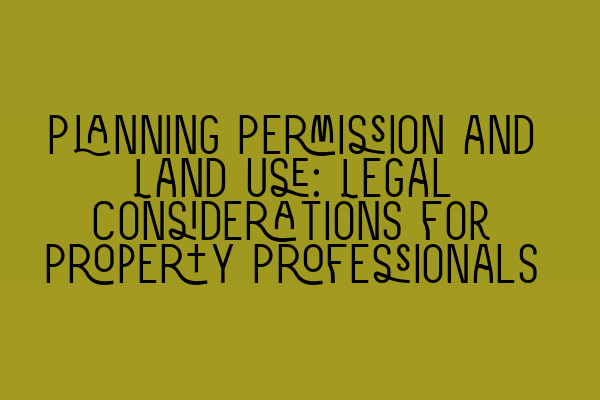Planning Permission and Land Use: Legal Considerations for Property Professionals
Introduction
As property professionals, understanding the legal framework surrounding planning permission and land use is crucial. Whether you are a solicitor, surveyor, or developer, having a firm grasp of the relevant laws and regulations can save you time, money, and potential legal complications. In this blog post, we will explore the key legal considerations when it comes to planning permission and land use.
1. What is Planning Permission?
Planning permission is the legal approval required for the development or change of use of land or buildings. It is granted by the local planning authority (LPA), which assesses whether the proposed development complies with local and national planning policies. Obtaining planning permission is essential to ensure that any development is lawful and does not contravene any regulations.
2. Types of Planning Permission
There are several types of planning permission, including:
a) Full Planning Permission: This is the most common type of permission and grants approval for a specific development or change of use.
b) Outline Planning Permission: This grants approval in principle for a proposed development, without specifying details such as the design or appearance of the development. Further detailed planning permission is required before construction can begin.
c) Reserved Matters Permission: This is sought after the grant of outline planning permission and deals with the specific details that were not determined at the outline stage, such as the design, appearance, and layout of the development.
3. The Planning Application Process
The planning application process can be complex and involves several stages. It is crucial to create a well-prepared and comprehensive application to increase the chances of success. Here are some key steps:
a) Pre-Application Stage: Before submitting a planning application, it is advisable to engage in pre-application discussions with the LPA to ensure that the proposed development aligns with local planning policies. This can help identify any potential issues or concerns early on.
b) Submission of Application: Once the application is prepared, it must be submitted to the LPA. This typically includes detailed plans, documents, and any required fees.
c) Statutory Consultation: The LPA will consult with various authorities and stakeholders, such as the Highways Agency, Environmental Agency, and neighbors, regarding the proposed development. Their comments and objections will be considered during the decision-making process.
d) Decision Making: The LPA will review the application and make a decision within a specified timeframe, usually eight weeks for householder applications and 13 weeks for major applications. The decision may be granted, refused, or subject to conditions.
e) Appeals: If the application is refused or granted with unfavorable conditions, there is a right to appeal to the Planning Inspectorate. Seeking legal advice at this stage is crucial to navigate the appeals process successfully.
4. Legal Considerations for Property Professionals
As property professionals, there are several key legal considerations to keep in mind when dealing with planning permission and land use:
a) Compliance with Planning Policies: It is essential to ensure that any proposed development aligns with local and national planning policies. Familiarize yourself with the local development plan and any supplementary planning documents to stay up to date with the latest regulations.
b) Environmental Impact Assessments: In certain cases, an Environmental Impact Assessment (EIA) may be required. This involves assessing the potential environmental effects of a proposed development and considering mitigation measures. Ensure that you are aware of the criteria triggering an EIA and the associated legal requirements.
c) Dealing with Objections and Appeals: If objections are raised during the planning process or an application is refused, it is crucial to handle them properly. Engage in constructive discussions and consider potential amendments to address concerns. If necessary, seek legal advice to appeal the decision effectively.
d) Overcoming Restrictive Covenants: Restrictive covenants may limit the use or development potential of a property. It is important to review the title deeds and consult with a solicitor to determine the enforceability of any covenants and explore ways to overcome them if necessary.
e) Negotiating Section 106 Agreements: Section 106 agreements are legal obligations imposed on developers by the LPA to address certain impacts arising from a proposed development. Negotiating favorable terms and ensuring compliance with these agreements are essential to avoid potential legal disputes in the future.
Conclusion
Planning permission and land use are complex areas of law that property professionals must navigate. By understanding the legal considerations and following the correct procedures, you can ensure that your developments are compliant, minimize legal risks, and achieve successful outcomes. For more information on related legal topics, be sure to check out our related articles on misrepresentation in contracts, understanding contractual capacity, and joining our SQE Contract Law webinars for expert insights and guidance.
Related Articles:
Misrepresentation in Contracts: Unveiling Deceptive Practices
SQE Contract Law: Analyzing Landmark Cases and Influential Judicial Decisions
Understanding Contractual Capacity: Rights and Limitations
Interactive SQE Mock Tests for Contract Law: Test Your Knowledge
Join Our SQE Contract Law Webinars: Expert Insights and Guidance
